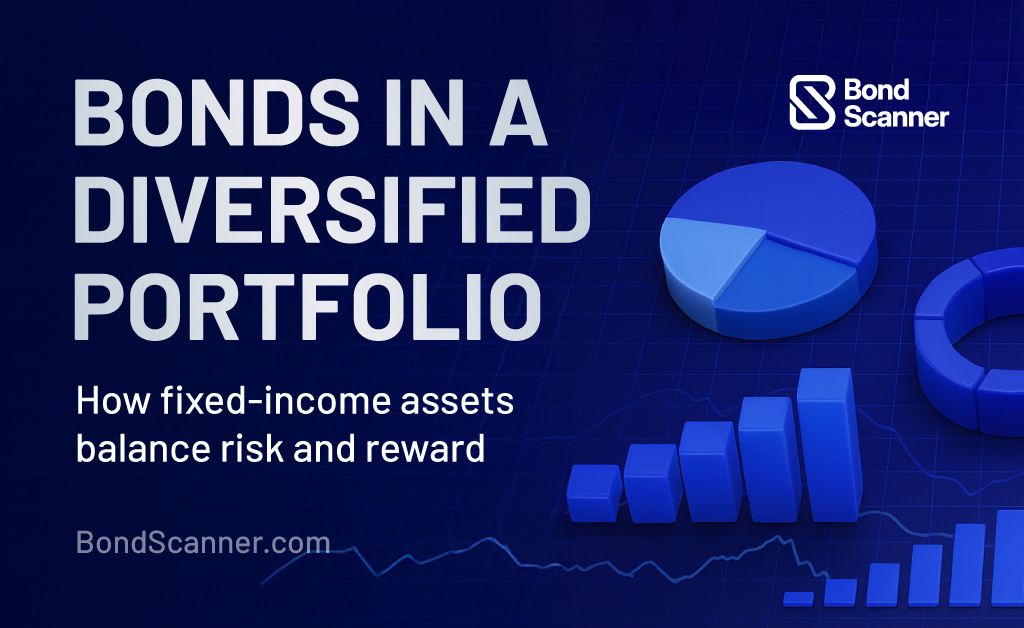Bonds in a Diversified Portfolio: How Fixed-Income Assets Balance Risk and Reward
13 October 2025

What Are Bonds and How Do They Work?
Diversification is one of the most important principles of investing. It helps investors reduce overall risk by spreading their money across different asset classes such as equities, bonds, and cash equivalents. Among these, bonds play a critical role by providing stability, predictable income, and downside protection—especially during volatile market phases.
In this article, we’ll explore how bonds in a diversified portfolio contribute to balancing risk and reward, their types, and how they help investors achieve long-term financial goals.
A bond is essentially a loan made by an investor to a borrower (typically a government or a company). In return, the borrower promises to pay regular interest—known as a coupon—and repay the principal at maturity.
Key terms to understand include:
Coupon Rate: The annual interest paid by the bond issuer.
Tenure: The period after which the bond matures.
Yield: The effective rate of return based on the bond’s price and coupon.
Credit Rating: A measure of the issuer’s creditworthiness, typically provided by rating agencies like CRISIL or ICRA.
Understanding these elements helps investors evaluate the risk and potential return associated with different bonds.
Why Diversification Matters in Investing
Diversification means not putting all your eggs in one basket. Market movements are unpredictable—when equities decline, bonds often hold or rise in value, providing a cushion against losses.
By blending fixed-income securities with equities and other assets, investors can reduce portfolio volatility without significantly sacrificing long-term returns.
According to financial studies, a balanced portfolio with both stocks and bonds tends to outperform all-equity portfolios in terms of risk-adjusted returns over the long term.
Role of Bonds in a Diversified Portfolio
Bonds add stability and predictability to an investment mix. Their performance typically contrasts with equities, which are driven by market sentiment and corporate earnings.
Here’s how bonds help in diversification:
Capital Preservation
Bonds, especially government securities, are considered relatively safer instruments that help preserve capital.
Steady Income Stream
Regular coupon payments offer predictable cash flows, which can be useful for retirees or conservative investors.
Risk Balancing
When equity markets become volatile, bond prices often move in the opposite direction, offsetting potential losses.
Inflation and Interest Rate Hedge
Certain types of bonds (like inflation-indexed bonds) can provide protection against rising prices, while short-duration bonds help manage interest rate risk.
Liquidity and Accessibility
Bonds are increasingly accessible through online platforms such as BondScanner, allowing investors to choose from government, corporate, or tax-free bonds in a transparent manner.
Types of Bonds for Portfolio Diversification
| Type of Bond | Issuer | Typical Features |
|---|---|---|
| Government Bonds (G-Secs) | Central/State Governments | Low risk, steady returns |
| Corporate Bonds | Private/Public Companies | Higher yields, moderate risk |
| Non-Convertible Debentures (NCDs) | Corporates | Fixed returns, tradable |
| Tax-Free Bonds | Government Entities | Tax-exempt interest income |
| 54EC Capital Gain Bonds | NHAI, REC, PFC, IRFC | Capital gains exemption u/s 54EC |
Risk and Reward with Bonds
Historical Perspective: Bonds as a Safety Net
Historically, bonds have demonstrated resilience during market downturns. For instance, during periods of equity market corrections, bond prices tend to rise as investors seek safety in fixed-income assets.
For example, during the 2020 market turbulence, government securities and AAA-rated corporate bonds performed comparatively better than equities, highlighting the importance of having fixed-income exposure.
Balancing Risk and Reward with Bonds
The optimal balance between bonds and equities depends on an investor’s goals, age, and risk profile. A younger investor might allocate more to equities for growth, while someone nearing retirement may prefer a higher bond allocation for stability.
A diversified approach—such as maintaining 60% equities and 40% bonds—has historically delivered consistent performance across market cycles. However, investors must periodically review and rebalance their portfolios to ensure alignment with changing market conditions and personal goals.
Risks Associated with Bonds
Although bonds are considered safer than equities, they are not entirely risk-free. Key risks include:
Credit Risk: The issuer might default on payments.
Interest Rate Risk: Rising interest rates can reduce bond prices.
Liquidity Risk: Some bonds may not be easily tradable.
Reinvestment Risk: Returns may decline if interest rates fall when reinvesting.
Investors should evaluate these risks carefully before investing.
FAQs
1. What role do bonds play in a diversified portfolio?
Bonds reduce overall risk and provide income stability. They balance the volatility of equity investments, ensuring smoother long-term returns.
2. Are bonds completely risk-free?
No. While bonds carry lower risk than equities, they are still subject to credit, interest rate, and liquidity risks.
3. How much of my portfolio should be in bonds?
The ideal allocation depends on factors like age, financial goals, and risk tolerance. Investors should consult financial advisors before deciding.
4. Can I invest in bonds online?
Yes. Platforms allow investors to explore and invest in bonds through transparent and SEBI-regulated mechanisms.
5. Do bonds offer better returns than equities?
Not necessarily. Bonds are designed for stability and income, while equities are aimed at long-term growth. Combining both provides a balanced approach.
Disclaimer
This blog is intended solely for educational and informational purposes. The bonds and securities mentioned herein are illustrative examples and should not be construed as investment advice or personal recommendations. BondScanner, as a SEBI-registered Online Bond Platform Provider (OBPP), does not provide personalized investment advice through this content.
Readers are advised to independently evaluate investment options and seek professional guidance before making financial decisions. Investments in bonds and other securities are subject to market risks, including the possible loss of principal. Please read all offer documents and risk disclosures carefully before investing.
Recent Blogs

Covered Bonds & Senior Secured Bonds Explained
An educational guide explaining covered bonds, senior secured bonds, what secured bonds mean, and how these instruments function in India’s bond market.
19 Dec 2025

Guide to Capital Gain Bonds (54EC) & Alternatives
An educational guide explaining capital gain bonds under Section 54EC, issuer options like PFC and SBI, eligibility rules, and alternatives for reinvesting sale proceeds.
19 Dec 2025

Bond ETFs in India: How They Work & When to Use Them
An educational guide explaining bond ETFs in India, their structure, returns, risks, and how products like Bharat Bond ETF and corporate bond ETFs function.
19 Dec 2025